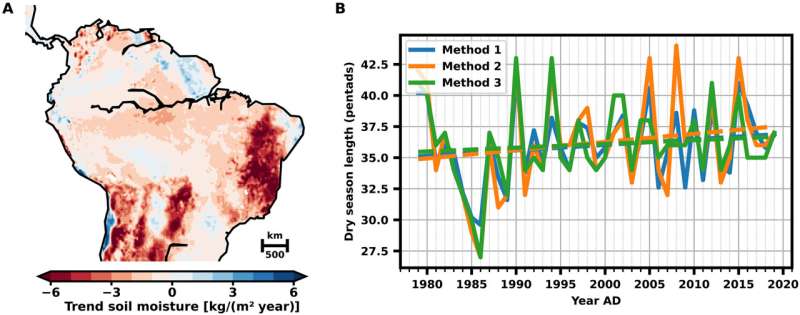October 5, 2023 report
This article has been reviewed according to Science X's editorial process and policies. Editors have highlighted the following attributes while ensuring the content's credibility:
fact-checked
peer-reviewed publication
trusted source
proofread
Model shows how Amazonian forest degradation and monsoon circulation are interlinked

A pair of concerned researchers, one a mathematician at the University of Norway, the other a climatologist at the Potsdam Institute for Climate Impact Research, has developed a computer model that shows linkages between forest degradation in the Amazon River basin and monsoon circulation.
In their paper published in the journal Science Advances, Nils Bochow and Niklas Boers describe the factors that went into creating their model and what it showed regarding a dieback tipping point. Notably, Science Advances also published a paper written by a team at George Mason University in 2019 that outlined possible implications of major changes to the Amazon River basin.
That research suggested that if deforestation continues in the Amazon River basin, it could lead to a tipping point at which a certain degree of change can cause permanent changes to an ecosystem. In the case of the Amazon, the change would be from rainforest to a drier, savanna-like climate.
Over the course of many years, many studies have been conducted to understand how the characteristics of the Amazon River basin work together to maintain such a large rainforest. Such studies have shown that regional water cycling along with moisture exaltation from the plants, together with sunlight and even dust blown over from Africa, all contribute to the unique ecosystem, the largest rainforest in the world.
Such work has also suggested that disruptions to parts of the system, such as cutting down trees, could result in major changes to the ecosystem. And if such changes were to occur, other studies have suggested the region would change from a rainforest to one that featured a vast savanna-like climate.
Such a possible change is of major concern to climate scientists because the rainforest produces a lot of the Earth's oxygen. Additionally, destruction of the trees would result in the release of carbon they sequester, likely into the atmosphere, contributing further to climate change. In this new effort, the researchers attempted to create a model that ties together degradation of the rainforest and monsoon circulation to show how and why a tipping point might be reached.
To create their nonlinear dynamical model, the pair used data from other models that have been built over the past 40 years to simulate conditions in the rainforest. They also added weather data for the same period, including rainfall amounts, wind speeds and direction, and degree of evapotranspiration. They then modeled the rainforest in its original state to serve as a starting point. Next, they tweaked parameters to see the effects on the entire system. The model showed that cutting down trees at current rates in the Amazon region would indeed lead to a tipping point.
They conclude that ecosystems with a feedback loop, such as the Amazon River basin, are particularly sensitive to change.
More information: Nils Bochow et al, The South American monsoon approaches a critical transition in response to deforestation, Science Advances (2023). DOI: 10.1126/sciadv.add9973
Journal information: Science Advances
© 2023 Science X Network




















